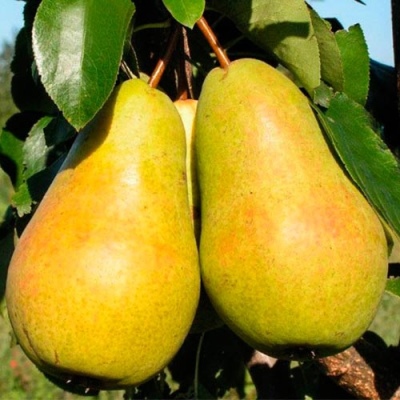
- Fruit weight, g: 80 (up to 250)
- Ripening terms: autumn
- Fruit picking time: from mid-September
- Appointment: universal
- Growth type: medium height
- Transportability: good
- Marketability: high
- Height, m: 3,5-4
- Crown: wide pyramidal
- Fruit shape: rounded pear-shaped
Many summer residents prefer to grow pear varieties on their plots, which are characterized by bountiful harvests and good adaptation to cold climates. These include the Autumn sweet pear variety, which is the most productive, growing in the Central region.
Breeding history
Sweet Autumn Pear is a fruit crop with a long history. Domestic breeders worked on the breeding of this pear species, whose task was to create a frost-resistant and fruitful variety. The pear is zoned in the Central region.
Description of the variety
Autumn Sweet is a medium-sized tree, reaching a height of 3.5-4 meters. The pear is characterized by a wide pyramidal crown shape with moderate thickening with dark green leaves and strong branches of a brown-brown color. Branches grow chaotically, so the tree looks quite voluminous.
Fruit characteristics
The pear represents a class of medium-fruited varieties. On average, the weight of the fruit is 80 grams, but recently the fruit has grown a little larger and is gaining weight up to 250 g. The shape of the fruit is correct - rounded pear-shaped with a moderately smooth surface. The peel of pears is thin, with a slight gloss and noticeable subcutaneous punctures. The ripe fruit is covered with a light yellow color, which is diluted with dull brown spots.
Pears tolerate transportation well and are endowed with a long keeping life (60-80 days), especially if the fruits are removed from the tree in a state of technical maturity - until mid-December. The purpose of fruits is universal - they are eaten fresh, used in cooking, processed and preserved. Fruits are well stored in wooden or cardboard boxes.
Taste qualities
Taste and commercial qualities of the variety are excellent. The white-creamy flesh has a delicate, fleshy, fine-grained and oily structure with a high juice content. The taste is balanced, with a dominant sweetness and a pleasant, dessert aroma that does not disappear even after prolonged storage.
Ripening and fruiting
The pear belongs to the autumn varieties. The tree begins to bear fruit in the 3-4th year after planting, and you can enjoy delicious pears annually (fruiting is stable and regular). Pear ripening peaks in the second half of September. According to experienced gardeners, pears should be removed at the stage of technical maturity, then they do not deform and are well preserved.

Yield
The tree yields good crops. With proper care, about 30 kg of ripe fruits can be harvested from one tree per fruiting season.
Growing regions
Pear tree Autumn sweet is massively grown in the Moscow region, in the Tula and Ryazan regions, as well as in the Urals and Western Siberia.
Self-fertility and the need for pollinators
The variety is self-fertile, therefore, it is possible to improve the yield indicators only with the help of donor trees, the flowering period of which coincides with the Autumn sweet pear. The most suitable pollinators are the following species: Svetlyanka, Severyanka, Rogneda, Yuryevskaya, Chizhovskaya.When planting pollinating seedlings, it is important to maintain the correct distance between them. Optimally, this is 6 meters between donor trees.
Landing
Saplings are planted in spring: late April - early May. During this period, the air and soil should warm up sufficiently. It is recommended to arrange seedlings according to a 5x4 or 6x3 m scheme. For planting, it is recommended to buy seedlings 1-2 years old, not 3-4 years old, since adult seedlings are more prone to various diseases.


Growing and care
The tree is not capricious in agricultural technology, but demanding on the soil and planting site. So, the site should be chosen on a small hill with good sunlight. In addition, the seedling must be protected from drafts and gusty winds. The rhizome of the tree does not like moisture stagnation, so it is better that the underground waters are deep. Pear soil loves loose, fertile and breathable. The pear should not be shaded by other trees planted on the site, as this can negatively affect the yield indicators.
Comprehensive tree care includes: abundant watering (for 2 weeks after planting, and then twice a month until September), fertilization (carried out 3 years after planting), weeding and mulching of the near-stem zone, annual sanitary pruning of branches, formation crowns, thinning of foliage, mandatory whitewashing, which protects against mechanical damage and infections, wrapping the trunk with spruce branches or burlap, as well as the prevention of viruses and insect attacks.



Disease and pest resistance
The immunity of the variety is average. The tree easily tolerates scab and many fungal diseases that pears are susceptible to. Insecticide treatments will help prevent the invasion of pests.

Like any other fruit trees, the pear needs protection from various diseases and pests. When planting a pear on your site, you need to know in advance what diseases you should beware of. To successfully carry out the struggle, it is necessary first to correctly identify the cause of the problem.It is important to distinguish signs of disease from manifestations of the presence of insects, mites, caterpillars and other types of pests.
Resistance to soil and climatic conditions
The pear has good stress resistance. It is winter-hardy, quickly adapts to the climatic characteristics of the region, tolerates temperature drops and heat. The pear tree reacts negatively to excessive shade, strong drafts and excess moisture in the soil.





































































